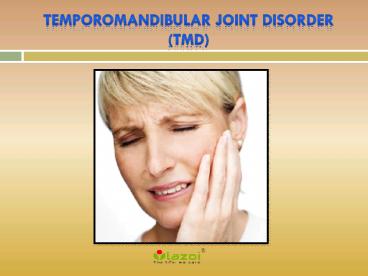Temporomandibular Joint Disorder (TMD): Symptoms and Treatment - PowerPoint PPT Presentation
Title:
Temporomandibular Joint Disorder (TMD): Symptoms and Treatment
Description:
If you experience pain in your ear and feel like chewing and grinding constantly, then you are probably affected by TMJ (temporomandibular joint) disorder. The temporomandibular joint (TMJ) is the part of body that is directly in front of the ear canal on both sides of the head where the upper jaw and lower jaw join. – PowerPoint PPT presentation
Number of Views:316
Title: Temporomandibular Joint Disorder (TMD): Symptoms and Treatment
1
Temporomandibular Joint Disorder (TMD)
2
Temporomandibular Joint Disorder (TMD)
- If you experience pain in your ear and feel like
chewing and grinding constantly, then you are
probably affected by TMJ (temporomandibular
joint) disorder. The temporomandibular joint
(TMJ) is the part of body that is directly in
front of the ear canal on both sides of the head
where the upper jaw and lower jaw join. The TMJ
consists of many moving parts, which make scope
for the upper jaw to close on the lower jaw. This
joint is a usual sliding ball and socket joint,
which has a disc in between the ball and the
socket. This joint is functional when we move the
jaw, bite or chew something, talk, or yawn. It is
one of the most frequently used joints in the
human body. TMD (temporomandibular disorder) is
the term that covers acute or chronic swelling of
the temporomandibular joint and muscles
surrounding it.
3
Temporomandibular Joint Disorder (TMD)
Continue
- The dysfunction that happens as a result of this
condition may lead to a lot of pain and
impairment. The exact cause of this condition is
not known however, it is believed to have
multi-factorial causes. These causes include
overactivity of the jaw muscles, increased
sensitivity of muscles to pain, wear and tear of
the joint, or injury to the jaw. Since the
disorder is beyond the demarcation of any one
discipline of medicine in particular,
like dentistry, neurology, physical therapy, and
psychology, there are a number of different
treatment approaches for this condition.
4
Symptoms
- TMJ disorders can be grouped together to form a
set of complex dysfunctions that are associated
with the jaw joint. The common symptoms of TMJ
disorder are - Most of the patients with TMD go through ear
pains, without any visible sign of infection. The
ear pain is generally felt in the front or below
the ear. An ear infection can be distinguished
clearly from a TMD, since there is hearing loss
or ear discharge in case of an ear infection. - Most of the patients also grind and clench their
teeth, which leads to an increase in the wear and
tear of the cartilage lining of the TMJ. - There are patients who can hear a constant
grinding, crunching, buzzing, or popping sounds
that may be medically termed as crepitus. These
sounds at times can be accompanied by increased
pain.
5
Symptoms
Continue
- Some people may also experience dizziness or
imbalance, something like vertigo. - Few patients report a clicking sound while
chewing or a jaw lock. - The jaw movement may be reduced in some cases,
which may give a general feeling of jaw being
stuck or locked.
6
Treatments
- There are various ways to treat TMD, which
include medications, heat, and ice therapy and
also soft diet. An acrylic splint or mouth guard
may be used to reduce or get rid of the grinding
and clenching of the teeth. This mouth guard fits
between the upper and lower teeth and prevents
them from coming together. It is usually
prescribed for the night but most of the patients
use it throughout the day. The splint also helps
to balance the bite. - It is suggested to keep the jaws apart as long as
possible so that teeth grinding can be avoided.
Patients are also advised against chewing gum,
and crunchy and chewy food items. - Heat and ice therapy may also be used to reduce
the muscle tension. This therapy also used in
case of TMJ injury.
7
Treatments
Continue
- If none of the aforementioned treatment options
work then, the last resort is surgery wherein the
ligaments may be tightened, the joints may be
restructured and replaced. This is the last
option and is only used in case of serious and
severe injury. - This condition is mostly treated with the use of
simple treatments, and may not require surgery.
However, the symptoms should not be overlooked as
they may cause a lot of discomfort.
8
CONNECT WITH US
- Logon to
- www.lazoi.com
- Like us on Facebook
- https//www.facebook.com/LazoiTheLife
- Follow us on Twitter
- https//www.twitter.com/lazoithelife
- Follow us on Pinterest
- https//www.in.pinterest.com/lazoithelife































